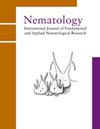Genotypic markers associated with cold storage survival of the entomopathogenic nematode Heterorhabditis bacteriophora
IF 1.1
4区 生物学
Q2 ZOOLOGY
引用次数: 0
Abstract
Limited shelf life is a major constraint to successful commercialisation of entomopathogenic nematodes (EPN), and to extend shelf life, dauer juveniles (DJ) are formulated and stored at low temperatures (4-8°C). We evaluated the cold storage potential of strains of Heterorhabditis bacteriophora formulated in diatomaceous earth at storage temperatures between 5 and 9°C. When assessing DJ decline to reach 75% survival (MT75) in the formulation for the respective temperatures, H. bacteriophora strain HB4 had the highest survival of 25 days at 9°C, while strain D2D6 survived longest at 8°C for 28 days. A set of 22 H. bacteriophora wild type inbred lines was then phenotyped for cold tolerance in water under oxidative stress in 70 mM H2O2 at 2°C. The MT50 (time to 50% survival) ranged from 11 to 23 days. The phenotypic data were correlated with the respective genotypic data, identifying four single nucleotide polymorphic (SNP) markers associated with cold tolerance. The survival of two lines (PT11 and IR11) with opposite extreme cold tolerance pheno- and genotypes was evaluated in diatomaceous earth formulation at 2°C with the cold tolerant IR11 surviving 3 days longer than PT11. Our study yields a set of valuable SNP markers employable in rapid genotyping of cold tolerance and tracking this trait during the breeding process.与昆虫病原线虫冷藏存活率相关的基因型标记
有限的保质期是昆虫病原性线虫(EPN)成功商业化的主要制约因素,为了延长保质期,我们配制了dawer幼虫(DJ),并在低温(4-8°C)下储存。我们评估了在硅藻土中配制的异habditis bacteriophora菌株在5 - 9°C的储存温度下的冷藏潜力。在不同温度下,当评估配方中DJ下降达到75%存活率(MT75)时,菌株HB4在9°C下的存活率最高,为25天,而菌株D2D6在8°C下的存活率最长,为28天。在70 mM H2O2和2°C条件下,对22个野生型噬菌体自交系进行了耐冷表型分析。MT50(至50%生存时间)为11 ~ 23天。表型数据与各自的基因型数据相关,鉴定出4个与耐寒性相关的单核苷酸多态性(SNP)标记。在2°C硅藻土配方中,研究了具有相反极端耐寒表型和基因型的两个品系(PT11和IR11)的存活率,耐寒品系IR11比PT11多存活3天。我们的研究产生了一组有价值的SNP标记,可用于快速的耐寒性基因分型和在育种过程中跟踪该性状。
本文章由计算机程序翻译,如有差异,请以英文原文为准。
求助全文
约1分钟内获得全文
求助全文
来源期刊

Nematology
生物-动物学
CiteScore
2.60
自引率
33.30%
发文量
67
审稿时长
3 months
期刊介绍:
Nematology is an international journal for the publication of all aspects of nematological research (with the exception of vertebrate parasitology), from molecular biology to field studies. Papers on nematode parasites of arthropods, and on soil free-living nematodes, and on interactions of these and other organisms, are particularly welcome. Research on fresh water and marine nematodes is also considered when the observations are of more general interest.
Nematology publishes full research papers, short communications, Forum articles (which permit an author to express a view on current or fundamental subjects), perspectives on nematology, and reviews of books and other media.
 求助内容:
求助内容: 应助结果提醒方式:
应助结果提醒方式:


